Nonlinear Model and Ballistic Impact of Body Aerodynamics for Canard Dual-Spin Aircraft
Abstract
1. Introduction
2. Numerical Simulation Methodology and Validation
2.1. Problem Description
2.2. Grid Discretization
2.3. Numerical Simulation Methodology
2.4. Validation of Results Convergence
2.5. Validation of Numerical Methods
3. Nonlinear Aerodynamics Modeling
3.1. Model of Body Nonlinear Aerodynamics
- When γF and υ are maintained at constant values, the aerodynamic forces and moments acting on the aircraft body exhibit highly nonlinear characteristics as δ increases. This indicates that the high-order terms of cx, cy, cz, my, and mz with respect to δ need to be retained.
- With δ held constant, the aerodynamic forces and moments acting on the aircraft body undergo periodic variations as the angle β (β = γF − υ) between the forebody longitudinal symmetry plane and the complex angle of attack plane. However, it is inappropriate to simply fit these to the trigonometric functions of β.
- As γF, υ, and δ change, the variations of my and mz differ significantly from those of cz and cy, respectively, suggesting that the position of each aerodynamic force action point is also characterized by strong nonlinearity. Therefore, the influence of various disturbance factors on these positions should not be neglected.
3.2. Solution of Unknown Parameters
3.3. Evaluation of Model Effects
- By comprehensively considering the influences of factors such as δ, υ, and γF, it enables precise calculations of the body aerodynamic force and moment under any flight conditions based on a finite set of parameters. This provides a basis for developing the accurate nonlinear ballistic theories and analyzing the modified ballistics.
- It completely reflects the intricate relationship between the body aerodynamic force and moment and the flight state as well as incoming flow conditions. The depiction of the nonlinear and periodic characteristics is more realistic, facilitating the study of the nonlinear angular motion and the flight stability of this type of aircraft.
- Through the decoupling analysis of the aerodynamic moment, the relatively complicated mechanical nature of its nonlinearities is elucidated in comparison to the body aerodynamic force. Specifically, the body aerodynamic force action points exhibit strong nonlinear characteristics that differ from those of the body aerodynamic force.
- Once the nth-order polynomials of the body aerodynamic force and moment coefficient pairs δ corresponding to multiple sets of β are known, the parameters satisfying the accuracy requirements can be efficiently determined by solving two sets of homogeneous linear equations. This significantly reduces the preliminary work required.
4. Numerical Simulation Analysis
4.1. Analysis of Nonlinear Aerodynamic Characteristics
- As δ gradually increases, the nonlinear characteristics of aerodynamic forces and moments acting on the aircraft body become more complicated with changes in γF. This complexity manifests not only in the relatively large amplitude of fluctuations but also shifts in the positions of extreme points and even the emergence of multiple extrema within a single cycle. Consequently, to ensure the accuracy of the model, it is inappropriate to simply approximate cx, cy, cz, my, and mz as trigonometric functions of β.
- Under the specified incoming flow conditions, the fluctuation patterns of my and mz with γF vary compared to those of cz and cy, respectively. There are significant differences in trends at different δ values. Therefore, according to Equation (8), the positions of the body aerodynamic force application points for this type of aircraft also exhibit strong nonlinear characteristics that depend on both δ and β.
4.2. Validation of Nonlinear Aerodynamic Model
4.2.1. Simplification and Parameter Solution
- When considering the 2nd- or 3rd-order nonlinear terms and utilizing the 2nd-order Fourier series for parameters transformation, the solutions obtained from the nonlinear aerodynamic model align closely with the CFD simulation results. Specifically, under the given Mach number, the accurate predictions of the body aerodynamic forces and moments at arbitrary complex angles of attack and forebody roll angles can be realized using the finite parameters, based on the aerodynamic parameters obtained from several experimental or simulation sets. This validates the reasonableness and feasibility of the model for the body aerodynamic force and moment established in this paper.
- Since the results corresponding to the 0th-order Fourier series are essentially obtained by using the model that retains the higher-order terms of δ based on the “Original model” but neglects the periodic characteristics of aerodynamic forces and moments, the models used in Refs. [4,5,6,7,8,9,10,11,25,26,27,28,29,30] are only applicable to cases where δ is relatively small or for calculating periodic average values under the uncontrolled flight with a freely rolling forebody. Theoretically, these models are unable to describe the fluctuating characteristics as shown in Figure 8, potentially resulting in maximum relative errors exceeding 100% for cz and my. In contrast, the model represented by Equations (21) and (22) can accurately capture the nonlinear aerodynamic forces and moments acting on the aircraft body under arbitrary δ, υ, and γF conditions. Therefore, the model established in this paper offers significant advantages for calculating the body nonlinear aerodynamic force and moment of this type of aircraft within a wider range of angles of attack.
4.2.2. Impact on Nonlinear Ballistics
5. Conclusions
Author Contributions
Funding
Data Availability Statement
Conflicts of Interest
References
- Pettersson, T.; Buretta, R.; Cook, D. Aerodynamics and Flight Stability for a Course Corrected Artillery Round. In Proceedings of the 23rd International Symposium on Ballistics, Tarragona, Spain, 16–20 April 2007; pp. 647–653. [Google Scholar]
- Xing, B.N.; Du, Z.H.; Du, C.X. Review on Two-Dimensional Trajectory Correction Projectile and Its Guidance and Control Technology. J. Natl. Univ. Def. Technol. 2021, 43, 53–68. [Google Scholar]
- Wang, Z.Y.; Shi, J.G.; Chang, S.J.; Li, Y.; Chen, Q.; Yi, W.J.; Wang, X.G. Review on Development of Technology of Trajectory Correction Projectile. J. Ballist. 2021, 33, 1–12. [Google Scholar]
- Costello, M.; Peterson, A. Linear Theory of a Dual-Spin Projectile in Atmospheric Flight. J. Guid. Control Dyn. 2000, 23, 789–797. [Google Scholar] [CrossRef]
- Zhao, X.X.; Shi, J.G.; Wang, Z.Y.; Zhang, N. Study on Angular Motion Characteristics and Control Stability with the Fixed Canard Dual-Spin Projectile. J. Harbin Inst. Technol. 2022, 54, 123–131. [Google Scholar]
- Theodoulis, S.; Gassmann, V.; Wernert, P.; Dritsas, L.; Kitsios, I.; Tzes, A. Guidance and Control Design for a Class of Spin-Stabilized Fin-Controlled Projectiles. J. Guid. Control Dyn. 2013, 36, 517–531. [Google Scholar] [CrossRef]
- James, M.M. Efficient Attitude Estimation for a Spin-Stabilized Projectile. J. Guid. Control Dyn. 2016, 39, 339–350. [Google Scholar]
- Ma, G.L.; Cai, H.M.; Chang, S.J. Analysis of Dynamic Stability of Fixed Canard Dual-Spin Projectile. Acta Armamentarii 2019, 40, 1987–1994. [Google Scholar]
- Norris, J.; Hameed, A.; Economou, J.; Parker, S. A Review of Dual-Spin Projectile Stability. Def. Technol. 2020, 16, 1–9. [Google Scholar] [CrossRef]
- Zhang, D.J.; Zhang, J.; Jiao, Z.G.; Ni, Q.J.; Guo, Q.P. Correction-Efficiency-Coefficient-Based Trajectory Optimization for Two-Dimensional Trajectory Correction Projectile. Aerospace 2022, 9, 149. [Google Scholar] [CrossRef]
- Krishna, A.B.; Kothari, M.; Abhishek, A. Guidance and Control of Spin-Stabilized Projectiles Based on Super Twisting Algorithm. J. Guid. Control Dyn. 2023, 46, 417–617. [Google Scholar] [CrossRef]
- Regan, F.J.; Smith, J. Aeroballistics of a Terminally Corrected Spinning Projectile (TCSP). J. Spacecr. Rocket. 1975, 12, 733–738. [Google Scholar]
- Xu, H.W.; Chen, S.S. Comparison of Aerodynamic Characteristics of Two-Dimension Trajectory Correction Projectile with Reverse-rotation and Non-rotation PGK. J. Ballist. 2018, 30, 32–37. [Google Scholar]
- Liu, X.D.; Wu, X.S.; Yin, J.T. Aerodynamic Characteristics of a Dual-Spin Projectile with Canards. Proc. Inst. Mech. Eng. Part G J. Aerosp. Eng. 2019, 233, 4541–4553. [Google Scholar] [CrossRef]
- Feng, B.; Yu, J.Y.; Ju, T.; Wang, X.M.; Wang, Y. Numerical Study of Asymmetrical Load on the Body of Dual-Spin Projectile. Acta Armamentarii. 2018, 39, 2118–2126. [Google Scholar]
- Feng, B.; Yu, J.Y.; Wang, X.M.; Wang, Y. Numerical Study on the Flow Around Dual-Spin Rocket Projectile Body. J. Ballist. 2021, 33, 21–27. [Google Scholar]
- Silton, S.I.; Fresconi, F. Effect of Canard Interactions on Aerodynamic Performance of a Fin-Stabilized Projectile. J. Spacecr. Rocket. 2015, 52, 1430–1442. [Google Scholar] [CrossRef]
- Zhang, J.W.; Lei, J.M.; Niu, J.P. Numerical Investigation of Aerodynamic Characteristics of Free-Spinning Tail Projectile with Canards Roll Control. Proc. Inst. Mech. Eng. Part G J. Aerosp. Eng. 2021, 235, 687–702. [Google Scholar] [CrossRef]
- Qian, L.; Chang, S.J.; Yang, W.L.; Wei, W. Simulation on Nonlinear and Unsteady Aerodynamic Characteristics of Fixed-Canard Correction Projectile. J. Ballist. 2020, 32, 31–37. [Google Scholar]
- Ji, X.L.; Wang, H.P.; Zeng, S.M.; Li, D.G. CFD Prediction of Longitudinal Aerodynamics for a Spinning Projectile with Fixed Canard. Trans. Beijing Inst. Technol. 2011, 31, 265–268. [Google Scholar]
- Zhang, D.J.; Zhang, J.; Jiao, Z.G.; Ni, Q.J. Research on Aerodynamic Characteristics of Correction Mechanism of Two-Dimensional Trajectory Correction Projectile. J. Ballist. 2021, 33, 34–39. [Google Scholar]
- Cheng, J.; Yu, J.Y.; Wang, X.M.; Yao, W.J. Engineering Modeling and Identification of Aerodynamics of Trajectory Correction Projectile with Decoupled Canards. Acta Armamentarii 2014, 35, 1542–1548. [Google Scholar]
- Feng, B.; Yu, J.Y.; Wang, Y.; Wang, X.M.; Ju, T. Improvement and Parameter Identification of Correction Force Model for Fixed-Canard Guidance Kit. Acta Armamentarii 2019, 40, 257–264. [Google Scholar]
- Zhong, Y.; Wang, L.M.; Li, Y.; Yang, Z.W. Calculation Model of Normal Force of Canard on Spin Stabilized Two-Dimensional Trajectory Correction Projectile. J. Ballist. 2019, 31, 48–54. [Google Scholar]
- Chang, S.J. Dynamic Response to Canard Control and Gravity for a Dual-Spin Projectile. J. Spacecr. Rocket. 2016, 53, 558–566. [Google Scholar] [CrossRef]
- Steven, T.; Spilios, T.; Sovanna, T.; Michael, P. Nonlinear Dynamic Inversion Flight Control Design for Guided Projectiles. J. Guid. Control Dyn. 2020, 43, 975–980. [Google Scholar]
- Fresconi, F.; Rogers, J. Flight Control of a Small-Diameter Spin Stabilized Projectile Using Imager Feedback. J. Guid. Control Dyn. 2015, 38, 181–191. [Google Scholar] [CrossRef]
- Zhao, X.X.; Shi, J.G.; Wang, Z.Y.; Zhang, N. Dynamic Stability and Influence Factors of the Whole Trajectory of Fixed Canard Dual-Spin Projectiles. Chin. J. Theor. Appl. Mech. 2022, 54, 1366–1376. [Google Scholar]
- Zhao, X.X.; Shi, J.G.; Wang, Z.Y.; Zhang, N. Nonlinear Angular Motion and Bifurcation Characteristics of Canard Dual-Spin Projectiles. Acta Armamentarii 2023, 44, 3067–3078. [Google Scholar]
- Li, H.Y.; Shen, Q.; Deng, Z.L. Analysis of Angular Motion and Swerving Response Characteristics of Dual-Spinning Two-Dimensional Correction Projectile With Canard Layout. Acta Armamentarii 2024, 45, 1866–1876. [Google Scholar]
- Chicco, D.; Warrens, M.J.; Jurman, G. The Coefficient of Determination R-Squared is more Informative than SMAPE, MAE, MAPE, MSE and RMSE in Regression Analysis Evaluation. PeerJ Comput. Sci. 2021, 7, e623. [Google Scholar] [CrossRef]


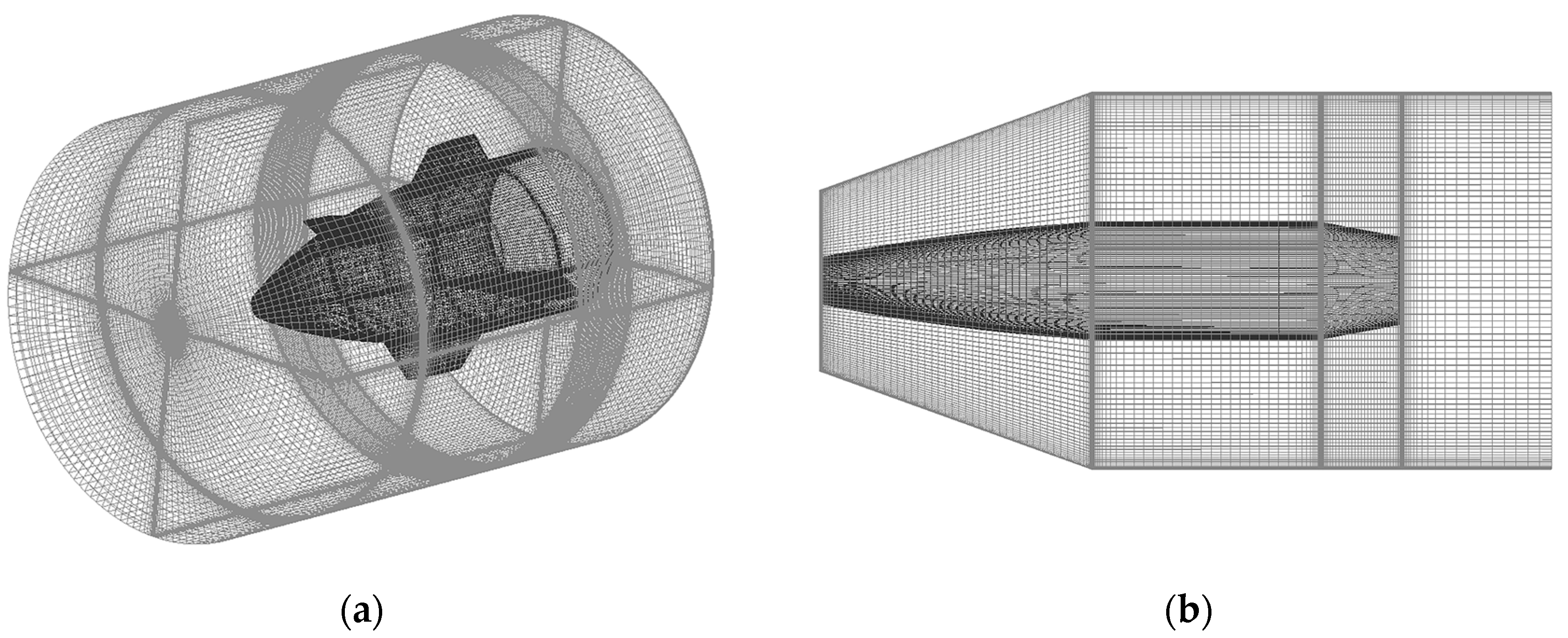



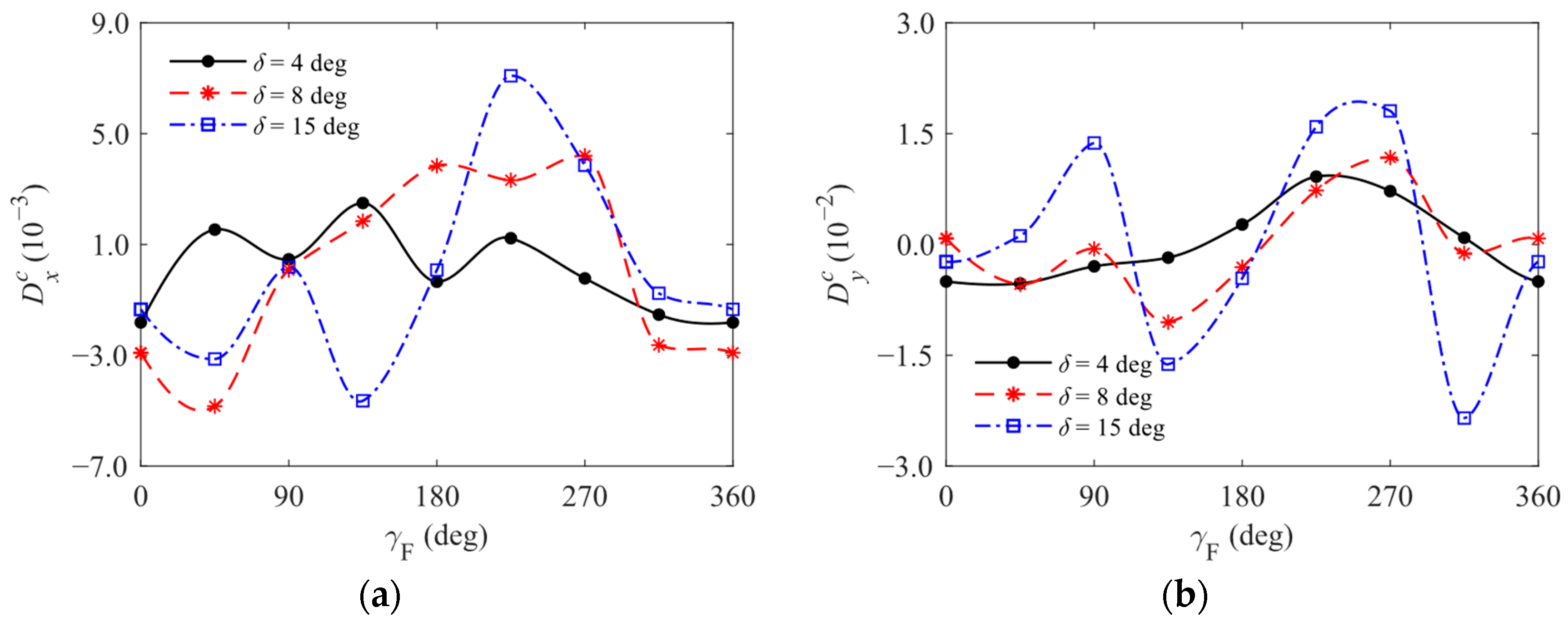

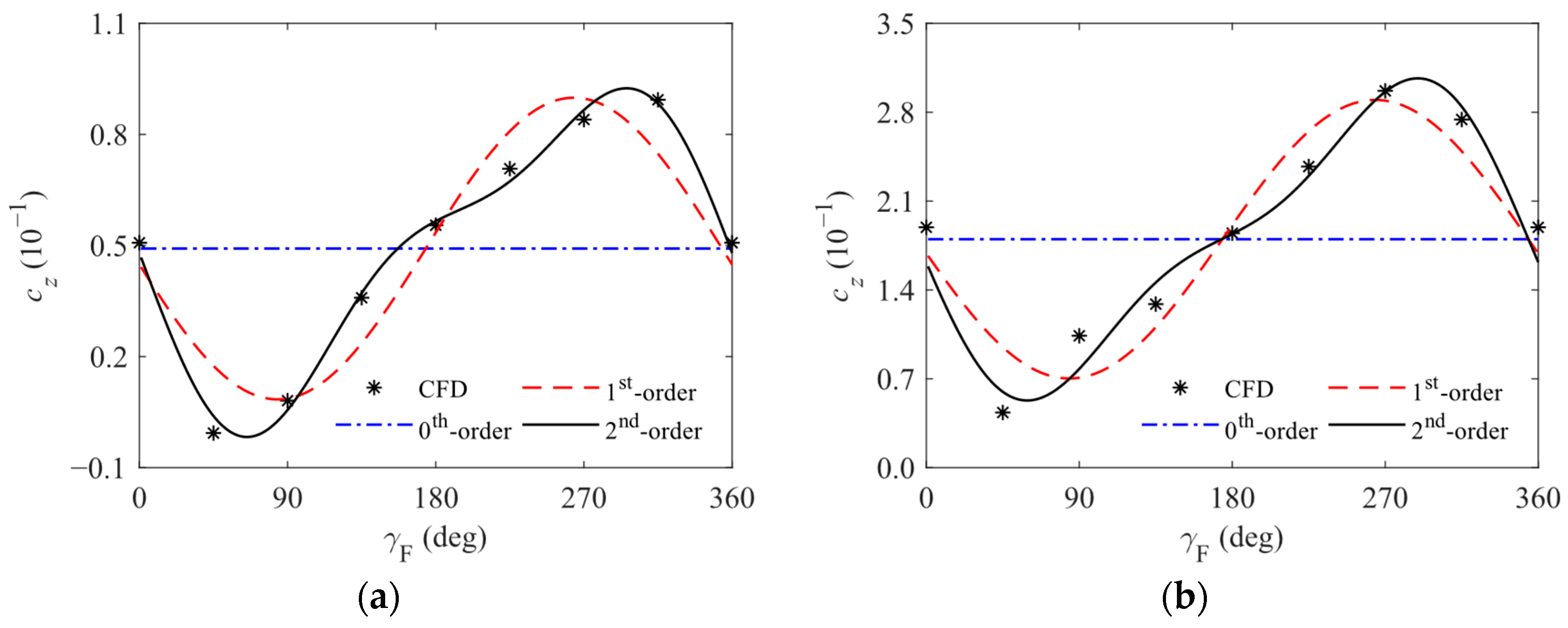
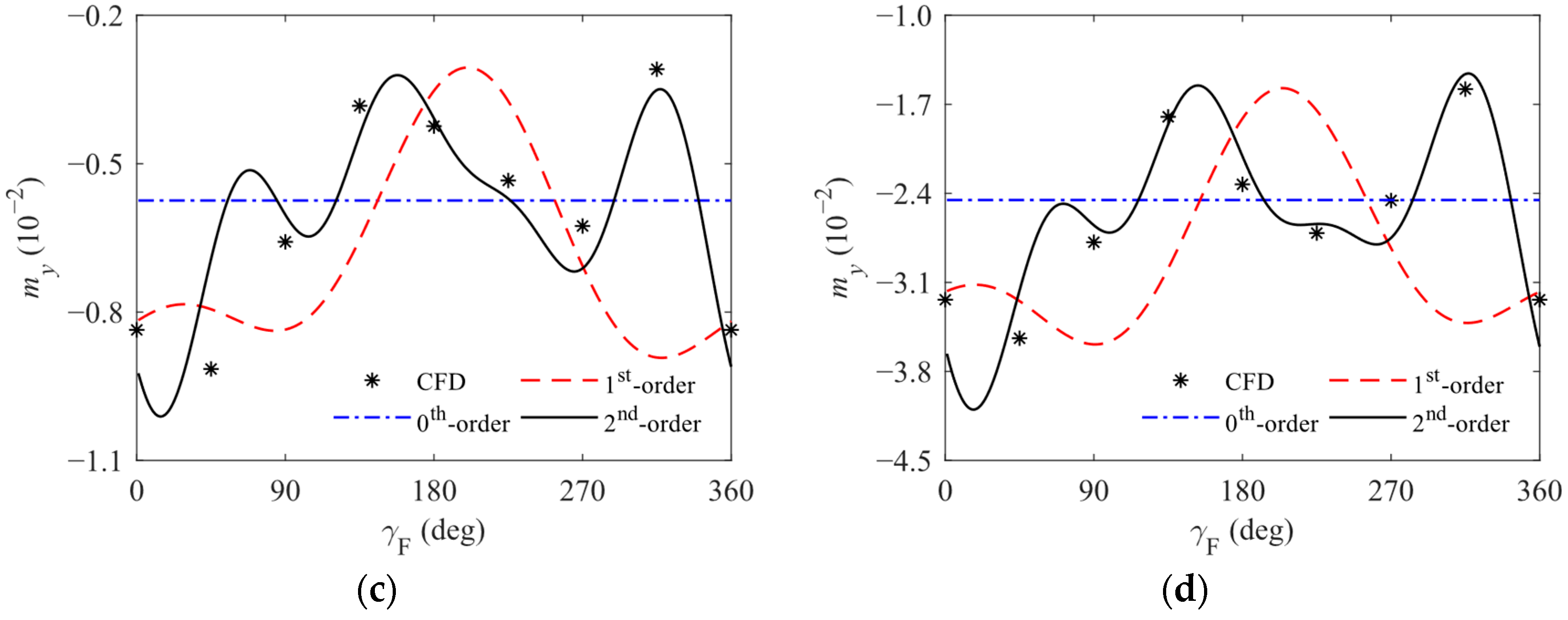

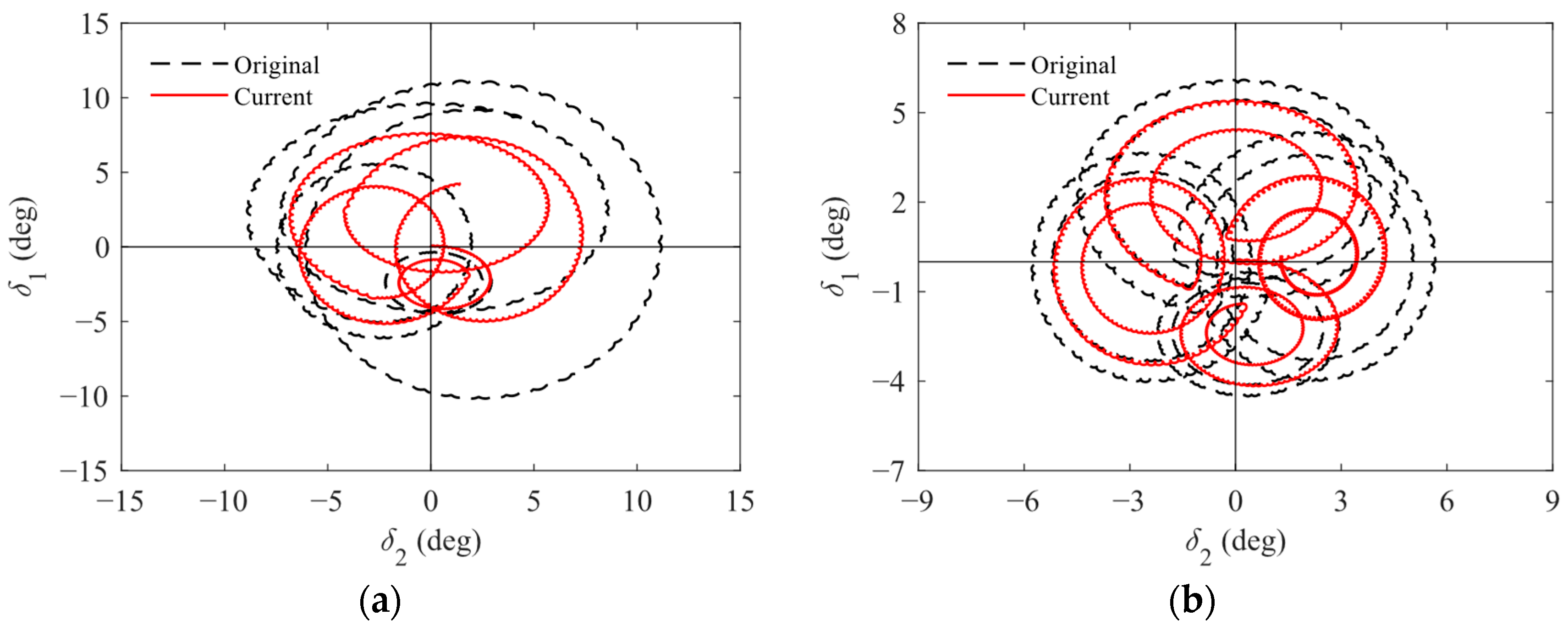
| m (kg) | d (m) | l (m) | L (m) | p (rad∙s−1) | δd (deg) | δf (deg) |
|---|---|---|---|---|---|---|
| 45.50 | 0.155 | 0.930 | 0.558 | 1800 | 6 | 4 |
| N (106) | Δt (10−6 s) | cNx (10−1) | cNy (10−1) | cNz (10−2) | mNy (10−3) | mNz (10−2) |
|---|---|---|---|---|---|---|
| 3.7 | 5 | −3.511 | 1.664 | −1.014 | −2.767 | 5.264 |
| 1 | −3.358 | 1.595 | −1.055 | −2.920 | 5.103 | |
| 5.8 | 5 | −3.319 | 1.570 | −1.093 | −3.010 | 4.979 |
| 1 | −3.297 | 1.557 | −1.101 | −3.041 | 4.931 | |
| 8.4 | 5 | −3.275 | 1.542 | −1.112 | −3.064 | 4.904 |
| 1 | −3.256 | 1.530 | −1.121 | −3.087 | 4.862 |
| Order | (%) | (%) | (%) | (%) | (%) |
|---|---|---|---|---|---|
| linear | 95.11 | 97.42 | 24.08 | 88.00 | 99.59 |
| 2nd | 99.78 | 99.93 | 70.06 | 99.88 | 99.98 |
| 3rd | 99.98 | 99.94 | 78.40 | 99.96 | 99.98 |
| δ (deg) | (%) | (%) | (%) | (%) | (%) |
|---|---|---|---|---|---|
| 4 | −0.60 | 4.33 | 41.73 | −154.80 | 3.13 |
| 8 | −1.24 | 2.46 | 83.68 | −44.38 | 2.55 |
| 15 | −1.12 | 2.16 | 59.24 | −31.78 | 4.25 |
| Parameter | ai,j,0 | ai,j,1 | bi,j,1 | ai,j,2 | bi,j,2 |
|---|---|---|---|---|---|
| f2,0 | 0.0030 | −0.0028 | −0.0020 | 0 | 0.0001 |
| f2,1 | 1.4517 | 0.0339 | −0.0141 | −0.0026 | −0.0027 |
| f2,2 | 5.2404 | −0.0951 | 0.0678 | −0.0317 | 0.0893 |
| f3,0 | 0 | −0.0245 | 0.0296 | 0 | 0 |
| f3,1 | 2.5091 | −0.0096 | 0.2726 | −0.0321 | 0.5821 |
| f3,2 | −4.5492 | 1.0115 | −18.3500 | 2.5374 | −10.7127 |
| f3,3 | 76.7267 | −5.3365 | 35.3742 | −11.0907 | 23.0542 |
| Parameter | ϕi,j,0 | ϕi,j,1 | φi,j,1 | ϕi,j,2 | φi,j,2 |
|---|---|---|---|---|---|
| h1,0 | −0.0073 | 0.0103 | 0.0010 | 0 | −0.0002 |
| h2,0 | −0.0106 | 0.0050 | −0.0207 | 0.0027 | −0.0015 |
| h3,0 | 3.1724 | −0.0638 | 0.0449 | 0.0264 | 0.0229 |
| h3,1 | −13.0066 | 0.7790 | −0.5276 | −0.0342 | −0.3291 |
| h4,0 | −1.1232 | 0.2216 | −0.3384 | −0.0972 | −0.0180 |
| h4,1 | 20.4686 | 2.7522 | −8.3549 | 3.2461 | −4.8852 |
Disclaimer/Publisher’s Note: The statements, opinions and data contained in all publications are solely those of the individual author(s) and contributor(s) and not of MDPI and/or the editor(s). MDPI and/or the editor(s) disclaim responsibility for any injury to people or property resulting from any ideas, methods, instructions or products referred to in the content. |
© 2025 by the authors. Licensee MDPI, Basel, Switzerland. This article is an open access article distributed under the terms and conditions of the Creative Commons Attribution (CC BY) license (https://creativecommons.org/licenses/by/4.0/).
Share and Cite
Zhao, X.; Shi, J.; Ren, H.; Wang, Z. Nonlinear Model and Ballistic Impact of Body Aerodynamics for Canard Dual-Spin Aircraft. Aerospace 2025, 12, 558. https://doi.org/10.3390/aerospace12060558
Zhao X, Shi J, Ren H, Wang Z. Nonlinear Model and Ballistic Impact of Body Aerodynamics for Canard Dual-Spin Aircraft. Aerospace. 2025; 12(6):558. https://doi.org/10.3390/aerospace12060558
Chicago/Turabian StyleZhao, Xinxin, Jinguang Shi, Huajie Ren, and Zhongyuan Wang. 2025. "Nonlinear Model and Ballistic Impact of Body Aerodynamics for Canard Dual-Spin Aircraft" Aerospace 12, no. 6: 558. https://doi.org/10.3390/aerospace12060558
APA StyleZhao, X., Shi, J., Ren, H., & Wang, Z. (2025). Nonlinear Model and Ballistic Impact of Body Aerodynamics for Canard Dual-Spin Aircraft. Aerospace, 12(6), 558. https://doi.org/10.3390/aerospace12060558






